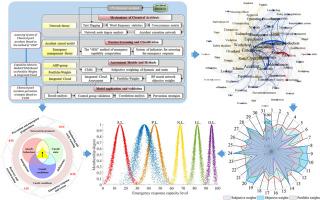Integrated cloud assessment of emergency response capability maturity in chemical parks based on "4SM" and improved portfolio empowerment
IF 4.2
3区 工程技术
Q2 ENGINEERING, CHEMICAL
Journal of Loss Prevention in The Process Industries
Pub Date : 2025-05-28
DOI:10.1016/j.jlp.2025.105696
引用次数: 0
Abstract
As an effective form of chemical industry, chemical park has gradually become an important support to promote global economic growth and a leading mode to improve the development of the industry. Firstly, to solve the problems of the uncertainty in the accident chain and the unclear information about emergency capability in the chemical park, an indicator system of emergency capability in the chemical park was created using 150 chemical accident cases, typical accident characteristics, complex network theory, and the "4SM" method. Secondly, a mix of dynamic and static weighting method was suggested, and an integrated cloud assessment model was built. The maturity level of chemical parks' emergency capability was assessed, and limitations were identified. The case study demonstrated that the maturity levels of emergency response capability of six chemical parks in China, were 36.2, 35.6, 48.8, 33.6, 55.9, and 43.8, respectively. Finally, the correlation analysis was used to verify the model. The comparative analysis results showed that the linear correlation of the experimental group and the control group was 0.916, and the two groups of values and fluctuation trends were consistent, indicating the reliability of the assessment model. The assessment methodology is of great significance for improving the emergency capability of chemical parks.

基于“4SM”和改进组合赋权的化工园区应急响应能力成熟度综合云评估
化工园区作为化工产业的一种有效形态,已逐渐成为促进全球经济增长的重要支撑和提升化工产业发展的主导模式。首先,针对化工园区事故链的不确定性和应急能力信息不清晰的问题,利用150个化工事故案例,结合典型事故特征,运用复杂网络理论,运用“4SM”方法,构建化工园区应急能力指标体系。其次,提出了动静混合加权法,建立了云综合评价模型;评价了化工园区应急能力的成熟度,指出了其不足之处。案例研究表明,中国6个化工园区的应急响应能力成熟度分别为36.2、35.6、48.8、33.6、55.9和43.8。最后,通过相关分析对模型进行验证。对比分析结果显示,实验组与对照组的线性相关性为0.916,两组值和波动趋势一致,说明评价模型的可靠性。该评价方法对提高化工园区应急能力具有重要意义。
本文章由计算机程序翻译,如有差异,请以英文原文为准。
求助全文
约1分钟内获得全文
求助全文
来源期刊
CiteScore
7.20
自引率
14.30%
发文量
226
审稿时长
52 days
期刊介绍:
The broad scope of the journal is process safety. Process safety is defined as the prevention and mitigation of process-related injuries and damage arising from process incidents involving fire, explosion and toxic release. Such undesired events occur in the process industries during the use, storage, manufacture, handling, and transportation of highly hazardous chemicals.

 求助内容:
求助内容: 应助结果提醒方式:
应助结果提醒方式:


